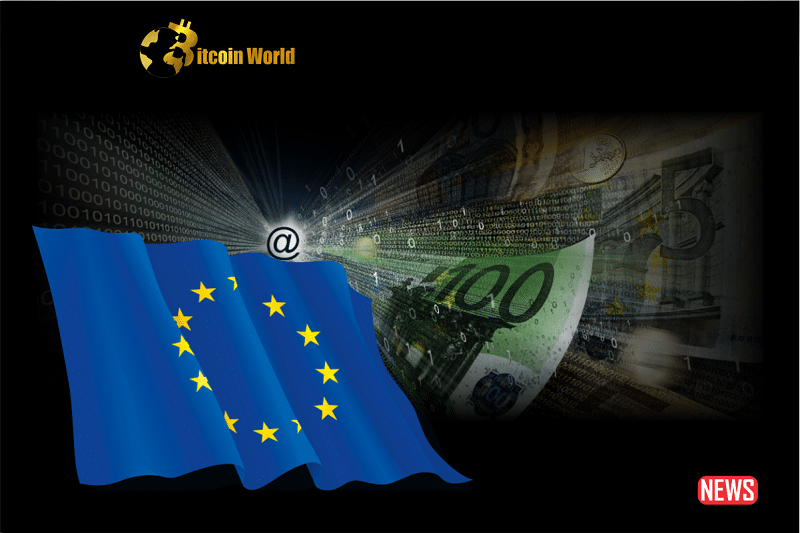Imagine a digital form of cash, backed by the European Central Bank (ECB), making transactions smoother and potentially reshaping how we handle money. That’s the digital euro, and it’s no longer just a concept. The European Union (EU) is seriously considering its introduction, as recent reports from Bloomberg News indicate. This move puts the EU at the forefront of a global trend towards central bank digital currencies (CBDCs). Let’s dive into what this means for you and the future of finance.
Why is the EU Considering a Digital Euro?
The push for a digital euro isn’t happening in isolation. Several factors are driving this initiative:
- Keeping Pace with Digitalization: Our world is increasingly digital, and money needs to evolve to keep up. A digital euro could streamline online payments and make financial services more accessible.
- Maintaining Monetary Sovereignty: With the rise of private cryptocurrencies and digital payment platforms, the EU wants to ensure it maintains control over its monetary policy.
- Enhancing Payment Efficiency and Innovation: A digital euro could foster innovation in the financial sector and reduce transaction costs.
- Ensuring Financial Stability: Paradoxically, while aiming to innovate, the ECB also needs to consider the potential impact on financial stability. This is why usage limits are being considered.
What Do We Know About the EU’s Plans So Far?
According to a leaked draft proposal, the European Commission is taking concrete steps. A key consideration is managing the potential impact on financial stability. Think about it: if everyone suddenly moved their bank deposits into digital euros, it could destabilize traditional banks. To address this, the proposal suggests imposing limits on how much digital euro an individual can hold as a store of value. This is a crucial balancing act – harnessing the benefits of a digital currency while mitigating risks.
What’s the Timeline for the Digital Euro?
The wheels are in motion! European finance ministers are meeting to discuss the initiative. The ECB kicked off its investigation phase in October 2021, with an expected conclusion in October of this year. According to the ECB’s official website, this phase is all about understanding the design, distribution, and potential market impact of a digital euro. A decision on whether to proceed with its development will follow this thorough assessment.
Is the EU Alone? The Global CBDC Race
Absolutely not! The digital euro is part of a much larger global trend. Check out this snapshot of worldwide CBDC activity:
| Region/Country | Status | Key Focus |
|---|---|---|
| European Union | Investigation Phase | Financial stability, monetary policy transmission |
| United States | Exploration Phase | Privacy concerns, potential benefits |
| China | Pilot Programs | Improving payment efficiency, internationalization |
| Nigeria | Launched (eNaira) | Financial inclusion, payment efficiency |
| G7 Economies | Development Stage | Modernizing financial systems |
Source: Atlantic Council
As you can see, the US Treasury is also actively exploring a digital dollar, with privacy being a central concern. Interestingly, while some US politicians like Florida Governor Ron DeSantis express concerns about potential government surveillance, the underlying interest in the technology remains strong. Globally, the numbers are striking: eleven countries have already launched a CBDC, and a staggering 114 countries – representing over 95% of global GDP – are actively exploring the possibilities. This is a massive leap from just 35 countries in May 2020!
What are the Potential Benefits of a Digital Euro?
- Simplified Payments: Imagine seamless, instant digital transactions across the Eurozone.
- Increased Financial Inclusion: A digital euro could provide access to financial services for those currently underserved.
- Enhanced Security: Backed by the ECB, it could offer a safer alternative to some private digital currencies.
- Greater Efficiency: Lower transaction costs and faster processing times.
- Innovation Catalyst: Potentially spurring new financial products and services.
What are the Potential Challenges?
- Privacy Concerns: Ensuring the privacy of transactions is paramount.
- Financial Stability Risks: Managing the potential shift of funds from commercial banks to the digital euro.
- Cybersecurity Threats: Robust security measures are essential to protect the digital currency.
- Technological Infrastructure: Building and maintaining the necessary infrastructure.
- Public Adoption: Ensuring widespread acceptance and use by citizens and businesses.
The Bottom Line: What Does This Mean for You?
The introduction of a digital euro could bring significant changes to how we interact with money in the EU. While the details are still being ironed out, the potential for a more efficient, accessible, and innovative financial landscape is clear. Keep an eye on developments as the ECB and EU policymakers navigate this complex but exciting journey. The digital euro is not just a technological upgrade; it’s a potential reshaping of the financial future for millions.
Disclaimer: The information provided is not trading advice, Bitcoinworld.co.in holds no liability for any investments made based on the information provided on this page. We strongly recommend independent research and/or consultation with a qualified professional before making any investment decisions.


